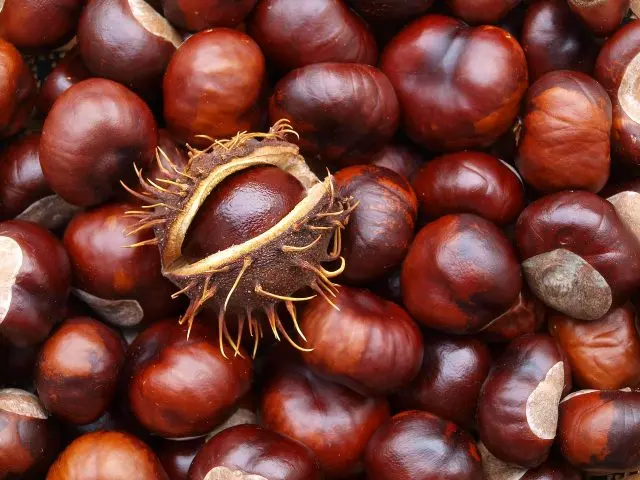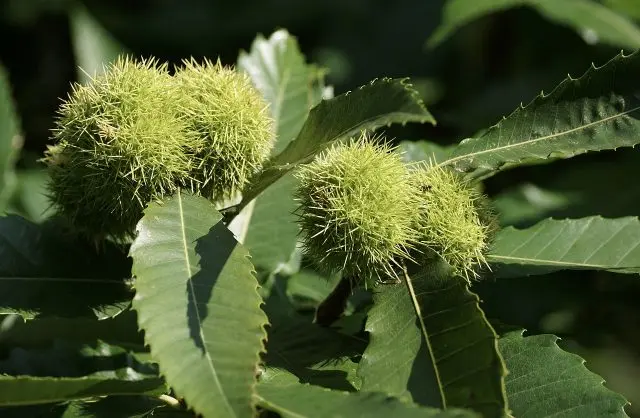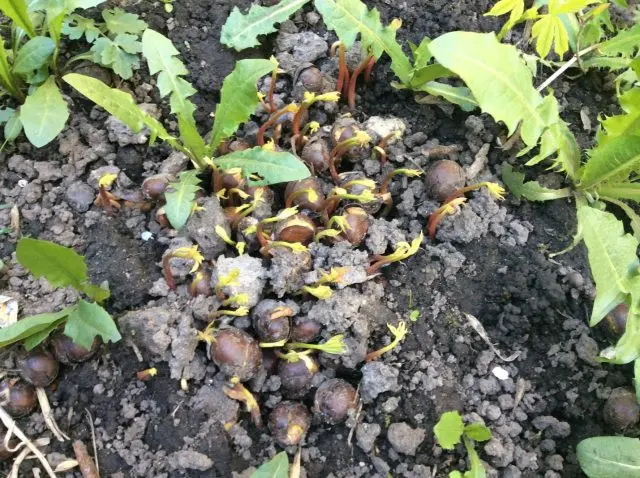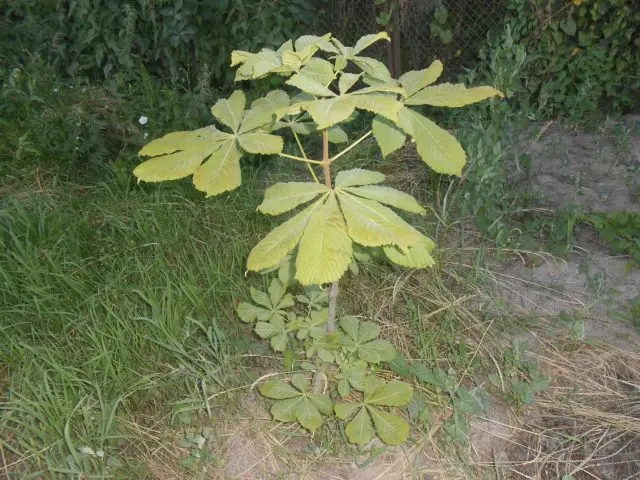Contents
Chestnut belongs to the Beech family. A high-growing tree is of two types: with nuts suitable for food – this is a noble variety, as well as horse, giving inedible fruits. For landscaping park areas, you can grow an alley of wild chestnuts. On a personal plot, you can place an acquired seedling or grow a chestnut from a nut yourself.

What does chestnut look like?
Deciduous, monoecious tree grows in the subtropical zone. In the wild, chestnut reaches a height of 40 meters, a trunk diameter of about 3 m. The culture is perennial, thermophilic, with a dense spreading crown. Asia Minor is considered the historical homeland, where culture grows on the slopes of the mountains from the shady side. In Our Country, trees can be grown in the Krasnodar Territory, Crimea, on the Black Sea coast and Transcaucasia. The seedling prefers non-limestone soil of medium moisture. On swampy and dry soils, the culture cannot be grown.
External characteristic:
- The bark is dark brown, thick, with deep furrows.
- The conical brown buds are round in shape and have four outer leathery scales.
- Stipules are oblong, light pink, up to 2 cm long, prone to rapid fall.
- The leaves are simple, two-row arrangement of the spiral type, fixed on short petioles. Oblong, lanceolate, wide, maximum length 25 cm. Apex pointed, hard surface with pinnate veins. The edges of the dark green leaf are serrated.
- After flowering, a seed box (plus) is formed, at the time of fruit formation it acquires a rounded shape. Inside soft, pubescent, the surface is equipped with hard branched spines. After the nut ripens, the plush splits into 4 parts, inside there are from 1 to 4 fruits.
- Nuts are flattened-oval in shape, tapering upwards. The surface is hilly at the base, a pronounced light spot of a rounded shape. The shell is glossy, dark brown, hard, leathery. Seeds spherical with a thick embryo. The structure is dense, with a high concentration of starch.
When hit on the ground, the nut quickly germinates, the cotyledons remain in the soil. Therefore, growing a chestnut tree from a chestnut fruit is not difficult.

How chestnut blossoms
The photo shows a chestnut tree branch during flowering, which occurs in May. The tree does not begin to bloom until the air warms up to the desired temperature. Frost affects flowers extremely rarely. The culture belongs to strong honey plants, the crown is always surrounded by a large number of bees. The plant is monoecious with heterosexual flowers, requires pollinators, therefore, during flowering, it exudes a persistent, tart aroma that attracts insects. A wild crop is grown as honey plants and for landscape design. It is possible to grow trees that produce edible fruits in personal plots.
Description of chestnut flowers:
- The flowers are zygomorphic, small in size, collected in large inflorescences, bisexual, painted white with pink or yellow splashes.
- Inflorescences – panicles up to 25 cm long, pyramidal, erect.
- Axle and pedicels with fine yellow pubescence.
- The anthers of the flowers are red, the pedicels are long, the edges are fringed. Equipped with 6 stamens and pistil.
It blooms in good weather until early June, the duration of flowering is 21 days.
The root system of chestnut
After the entrances, the chestnut begins to form a taproot, which deepens into the soil up to 40 cm in a year. At the same time, the stem grows, by the end of the year the height of the shoot reaches 20 cm. The root system of a young tree is very fragile.
The root system is not determined by the crown of the tree, it is much larger, goes beyond the border by 3-5 m, this factor must be taken into account when planting a crop close to other fruit trees.
The structure of the root system of an adult chestnut:
- The tap root goes deep to 4 m.
- There are processes of the first and second order, the first ones are formed less, the branches of the second plan develop several times more.
- Horizontal roots grow to the sides parallel to the surface by 4 meters.
- From horizontal roots go vertical branches deep into the ground.
The deep system, which has grown well to the sides, provides the tree with sufficient nutrition and moisture.
How long does a chestnut tree grow
This is a fast growing seedling. The end point reaches the 30th year of vegetation. It forms young shoots well even on a cut (stump). The annual growth is approximately 50 cm. Depending on the type of crop, at the age of 1 year, the height of a young tree can be 30 cm, by the end of the third year about 1,5 meters. If you managed to grow a chestnut from a fruit, it blooms for 10 years, will bear fruit up to 45 years. The grafted culture will bear fruit in the fifth year of vegetation.


How to distinguish between edible and non-edible chestnuts
The horse wild species brings inedible fruits, the purpose of planting is to decorate the landscape and create a base for honey plants. Growing edible chestnuts for the purpose of obtaining nuts is possible in the southern regions of Our Country. The difference between a noble species and a wild one is presented in the table.
Features | Plant with edible nut | Horse chestnut |
Leaves | Long single leaves growing one after the other with small spikes at the end of the teeth | Roughly veined, five-fingered, spineless, lanceolate, opposite |
Flowering | Inflorescence long drooping, flowers small, white, inconspicuous | An ornamental tree with large pyramidal upright inflorescences, flowers with yellow or pink spots and a strong smell |
Height | High-growing tree up to 35 meters with a dense crown | Barrel length no more than 15 m |
A plus | Densely studded with long spines | Spines short, rare |
The shape and size of the nut | Smooth surface of light brown color, small size, circle at the base is light gray | The surface is bumpy, dark brown, the nut is large, the circle is wide with a green tint. |
How to plant a chestnut
Chestnut propagation is carried out by cuttings, a seedling can be grown from a nut. The plant is heat-loving, drought-resistant, grows only in the subtropical zone; it is rather problematic to grow a crop in regions with a temperate climate due to return spring frosts. In order for the tree to be comfortable on the site, you need to plant the chestnut correctly.
How to choose the right nut for planting
It is possible to grow a chestnut from a nut in the country with the condition of acquiring high-quality planting material. Seed requirement:
- the fruits must be ripe and have fallen from the tree on their own. Small unripe fruits will not sprout;
- seeds are taken from a strong perennial plant;
- the nut should be firm and whole, without damage and dents.
When harvesting planting material, it is taken into account that out of 5 pieces, only one nut can germinate.
How to plant walnut chestnuts at home
There are two ways to grow a chestnut tree at home. Planting material is collected and stored until spring, then germinated and planted on the site. The second option – the autumn fruits are buried in the hole, in the spring they will sprout themselves. Pre-growing chestnuts for spring planting:
- The collected fruits are placed in a canvas bag, stored at a temperature close to zero.
- In the middle of winter, high-quality nuts are selected for tree cultivation, placed in a container, sprinkled with sand, removed to the balcony for hardening.
- After 2 weeks, the container is brought into a warm room, during which time the seeds will sprout, the material without sprouts is thrown away.
- Pour the nutrient mixture into small containers, deepen the nuts by 5 cm.
- After 20 days, the first shoots will appear.
- For unhindered access of oxygen to the nuts, the earth is constantly loosened, watered as the topsoil dries out.
It is necessary to first grow chestnuts from walnuts in pots, then, when the soil warms up completely in the spring, the seedling is placed in the allotted place, tentatively planting is done in early May.

Planting a chestnut from a nut immediately in open ground
In open ground, you can plant a chestnut from a nut in the fall, with the seeds of the current year. The decision to grow a crop by late planting has its advantages, the nuts will harden over the winter, sprout together, the seedling will receive good immunity.
The sequence of growing chestnut from walnut in open ground:
- 5 days before planting, the nuts are soaked in warm water.
- Make a depression of 10-15 cm, put the seeds, cover with soil.
- Cover with dry leaves on top.
To protect against rodents, it is recommended to cover the top with a chain-link mesh with small cells. Nuts will sprout in spring. Weak shoots are removed, leaving the right number of seedlings. Chestnuts grow until autumn. A month before the onset of frost, seedlings are determined for a permanent place. You can grow trees with single seeds, this method has its minus, not all nuts will sprout.
The sequence of planting seedlings:
- Make a landing pit 50 * 50.
- A mixture of sod layer, wood ash, compost and sand, taken in equal parts, is poured onto the bottom.
- At 20 cm from the center, a stake is killed.
- The seedling is placed so that the basal neck remains on the surface.
- The trunk is installed vertically in the center, covered with earth.
- In order for the tree to be even, it is fixed to a support.
- From above, the root circle is mulched with peat or dry sawdust.
How to grow a chestnut
On a personal plot, you can grow one, less often two plants. The tree needs a lot of space. The root system extends over a long distance, completely taking nutrients from the soil. Nothing can be grown within a radius of 5 m from it. If the planting is massive, then it is possible to grow trees 3 meters apart.
Watering and top dressing
Growing a healthy chestnut without regular feeding and watering is problematic. Watering is carried out up to 4 years of growth, then this measure is not relevant. The root system completely nourishes the plant and supplies enough moisture. Top dressing is carried out in early spring before the formation of leaves. Prepare a mixture for 20 liters of water:
- organic – 1 kg;
- phosphorus-potassium agent – 30 g;
- ammonium nitrate – 25 g;
- urea – 30 g.
The solution is applied under the root. Mulch with compost in autumn.
Trimming and shaping
Culture is unpretentious in care. To grow a chestnut with a beautiful crown, spring pruning is necessary. In order to prevent thickening and damage by a fungal infection, excess branches on chestnuts are removed. Young shoots are cut to ¼ length. They do sanitary cleaning, remove dry branches, shoots that have frozen over the winter, last year’s cups with nuts. Cut off the root shoots.

Preparation for winter
An adult chestnut does not require preparatory measures for wintering. It will not work to grow young seedlings up to 3 years of vegetation without shelter for the winter. Culture can die. To protect the roots in autumn, the root circle is mulched with straw or dry leaves. Supports are installed at the height of the crown around the plant, a tarpaulin or a special covering material is pulled over them, the trunk is wrapped with burlap.
Diseases and pests
The most common infection that affects the plant is powdery mildew and anthracnose. The disease manifests itself as white or brown spots on the leaves. The problem is eliminated with the antifungal drug “Fundazol”, in spring and autumn, for preventive purposes, the crown is treated with Bordeaux liquid. Insects parasitizing on the culture: driller, spider mite, bagworms. To eliminate them, a potent insecticide “Karbofos” is used.
Tips from experienced gardeners
Growing a chestnut from a nut at home is not difficult. Subject to the requirements of agricultural technology, in 10 years the tree will bear the first fruits. Experienced gardeners give advice on how to grow a beautiful tree at minimal cost:
- Do not plant a plant in a site with closely adjacent groundwater.
- Conduct moderate watering of young seedlings.
- Place the plant at a distance of 5 meters from the fence and other trees.
- When transplanting, it is taken into account that the root system is deep and does not correspond to the diameter of the crown.
- If the composition of the soil is calcareous, it will not work to grow a healthy chestnut; sawdust is mixed into the soil.
- Every spring, sanitary cleaning and pruning of young chestnut shoots are carried out.
- Do prophylactic treatment with Bordeaux liquid.
- In order to grow chestnut faster, be sure to feed the plant in the spring and, if necessary, cover it for the winter.
Conclusion
To plant a tree on a personal plot, you can purchase a ready-made seedling in a nursery or grow a chestnut from a nut yourself. With proper care: watering, fertilizing, protecting young seedlings for the winter, the plant will bloom and give nuts after a certain period of time. If there is a stationary apiary, you can grow chestnuts as a honey plant. To obtain nutritious fruits, an edible species is chosen for cultivation.









